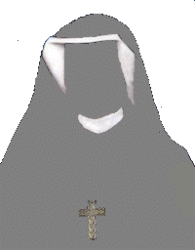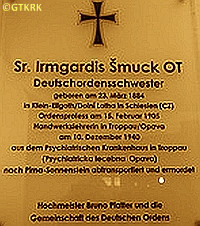Roman Catholic
St Sigismund parish
05-507 Słomczyn
85 Wiślana Str.
Konstancin deanery
Warsaw archdiocese, Poland
full list:
displayClick to display full list

searchClick to search full list by categories
wyświetlKliknij by wyświetlić pełną listę po polsku

szukajKliknij by przeszukać listę wg kategorii po polsku

Martyrology of the clergy — Poland
XX century (1914 – 1989)
personal data

religious status
surname
ŠMUCK
forename(s)
Leopoldina (pl. Leopoldyna)
religious forename(s)
Irmgardis (pl. Irmgarda)
function
nun
creed
Latin (Roman Catholic) Church RCmore on
en.wikipedia.org
[access: 2014.09.21]
congregation
Congregation of Sisters of Charity of the Teutonic Order OTmore on
second.wiki
[access: 2022.07.18]
(i.e. Teutonic Daughters of Charity)
date and place
of death
11.12.1940

TA SonnensteinSchloss Sonnenstein „euthanasia” center
today: Pirna, Sächsische Schweiz‐Osterzgebirge dist., Saxony state, Germany
more on
en.wikipedia.org
[access: 2022.07.18]
alt. dates and places
of death
12.12.1940
details of death
On 26.01.1916, admitted for treatment to a psychiatric hospital in Opava for the first time.
After Munich agreement of 29‐30.09.1938 when British and French caved in to Germans governed by the national–socialist party NSDAP — in the name of ultimately criminal Eng. „Appeasement” policy — and annexation of Czechoslovakia into Germany, after German and Russian invasion of Poland in 09.1939 and start of the World War II, transported out on 10.12.1940 of Opava — in one of the three such transports — to TA Sonnenstein extermination center in Pirna‐Sonnenstein castle, to the so‐called Euthanasia Institute.
There murdered in the gas chamber — as the victim of genocidal German «Aktion T4» plan.
cause of death
extermination
perpetrators
Germans
sites and events
TA SonnensteinClick to display the description, Ribbentrop‐MolotovClick to display the description, Pius XI's encyclicalsClick to display the description
date and place
of birth
23.03.1884

Ligota Małatoday: Niemcza gm., Dzierżoniów pov., Lower Silesia voiv., Poland
more on
en.wikipedia.org
[access: 2022.07.18]
religious vows
15.02.1905 (temporary)
18.07.1930 (permanent)
positions held
till 1940
patient — OpavaChech Silesia
today: Opava dist., Moravian‐Silesian reg., Czechia
more on
en.wikipedia.org
[access: 2022.08.05] ⋄ Psychiatric Hospital — prob. was treated periodically, the first time from 26.01.1916 (patient No. 7440), the last time till 10.12.1940, when was transported out to the murder site
from c. 1904
friar — OpavaChech Silesia
today: Opava dist., Moravian‐Silesian reg., Czechia
more on
en.wikipedia.org
[access: 2022.08.05] ⋄ Congregation's house, Teutonic Daughters of Charity OT
sites and events
descriptions
TA Sonnenstein: From 06.1940 to 09.1942, in Sonnenstein castle, the Germ. NS‐Tötungsanstal (Eng. National Socialist Extermination Center), i.e. TA Sonnenstein, operated. As part of «Aktion T4», program approx. 15,000 people — mostly mentally and mentally ill, but also prisoners of concentration camps, mainly from Saxony, Thuringia, Silesia and East Prussia — were murdered by the Germans in a gas chamber. After „examination”, the victims were forced to undress, and then, in groups of 20‐30 were taken to a cell‐room under the pretext of having to take a bath. The room was equipped with nozzles simulating shower heads. After closing the steel door, a German „doctor” opened the container with carbon monoxide and let it into the chamber. Death took place — closely watched by the camp staff — within 20‐30 minutes. (more on: pl.wikipedia.orgClick to attempt to display webpage
[access: 2012.11.23])
Ribbentrop‐Molotov: Genocidal Russian‐German alliance pact between Russian leader Joseph Stalin and German leader Adolf Hitler signed on 23.08.1939 in Moscow by respective foreign ministers, Mr. Vyacheslav Molotov for Russia and Joachim von Ribbentrop for Germany. The pact sanctioned and was the direct cause of joint Russian and German invasion of Poland and the outbreak of the World War II in 09.1939. In a political sense, the pact was an attempt to restore the status quo ante before 1914, with one exception, namely the „commercial” exchange of the so‐called „Kingdom of Poland”, which in 1914 was part of the Russian Empire, fore Eastern Galicia (today's western Ukraine), in 1914 belonging to the Austro‐Hungarian Empire. Galicia, including Lviv, was to be taken over by the Russians, the „Kingdom of Poland” — under the name of the General Governorate — Germany. The resultant „war was one of the greatest calamities and dramas of humanity in history, for two atheistic and anti‐Christian ideologies — national and international socialism — rejected God and His fifth Decalogue commandment: Thou shall not kill!” (Abp Stanislav Gądecki, 01.09.2019). The decisions taken — backed up by the betrayal of the formal allies of Poland, France and Germany, which on 12.09.1939, at a joint conference in Abbeville, decided not to provide aid to attacked Poland and not to take military action against Germany (a clear breach of treaty obligations with Poland) — were on 28.09.1939 slightly altered and made more precise when a treaty on „German‐Russian boundaries and friendship” was agreed by the same murderous signatories. One of its findings was establishment of spheres of influence in Central and Eastern Europe and in consequence IV partition of Poland. In one of its secret annexes agreed, that: „the Signatories will not tolerate on its respective territories any Polish propaganda that affects the territory of the other Side. On their respective territories they will suppress all such propaganda and inform each other of the measures taken to accomplish it”. The agreements resulted in a series of meeting between two genocidal organization representing both sides — German Gestapo and Russian NKVD when coordination of efforts to exterminate Polish intelligentsia and Polish leading classes (in Germany called «Intelligenzaktion», in Russia took the form of Katyń massacres) where discussed. Resulted in deaths of hundreds of thousands of Polish intelligentsia, including thousands of priests presented here, and tens of millions of ordinary people,. The results of this Russian‐German pact lasted till 1989 and are still in evidence even today. (more on: en.wikipedia.orgClick to attempt to display webpage
[access: 2015.09.30])
Pius XI's encyclicals: Facing the creation of two totalitarian systems in Europe, which seemed to compete with each other, though there were more similarities than contradictions between them, Pope Pius XI issued in 03.1937 (within 5 days) two encyclicals. In the „Mit brennender Sorge” (Eng. „With Burning Concern”) published on 14.03.1938, condemned the national socialism prevailing in Germany. The Pope wrote: „Whoever, following the old Germanic‐pre‐Christian beliefs, puts various impersonal fate in the place of a personal God, denies the wisdom of God and Providence […], whoever exalts earthly values: race or nation, or state, or state system, representatives of state power or other fundamental values of human society, […] and makes them the highest standard of all values, including religious ones, and idolizes them, this one […] is far from true faith in God and from a worldview corresponding to such faith”. On 19.03.1937, published „Divini Redemptoris” (Eng. „Divine Redeemer”), in which criticized Russian communism, dialectical materialism and the class struggle theory. The Pope wrote: „Communism deprives man of freedom, and therefore the spiritual basis of all life norms. It deprives the human person of all his dignity and any moral support with which he could resist the onslaught of blind passions […] This is the new gospel that Bolshevik and godless communism preaches as a message of salvation and redemption of humanity”… Pius XI demanded that the established human law be subjected to the natural law of God , recommended the implementation of the ideal of a Christian state and society, and called on Catholics to resist. Two years later, National Socialist Germany and Communist Russia came together and started World War II. (more on: www.vatican.vaClick to attempt to display webpage
[access: 2023.05.28], www.vatican.vaClick to attempt to display webpage
[access: 2023.05.28])
sources
personal:
deutscher-orden.atClick to attempt to display webpage
[access: 2022.07.18], newsaints.faithweb.comClick to attempt to display webpage
[access: 2014.10.31]
original images:
deutscher-orden.atClick to attempt to display webpage
[access: 2022.07.18]
LETTER to CUSTODIAN/ADMINISTRATOR
If you have an Email client on your communicator/computer — such as Mozilla Thunderbird, Windows Mail or Microsoft Outlook, described at WikipediaPatrz:
en.wikipedia.org, among others — try the link below, please:
LETTER to CUSTODIAN/ADMINISTRATORClick and try to call your own Email client
If however you do not run such a client or the above link is not active please send an email to the Custodian/Administrator using your account — in your customary email/correspondence engine — at the following address:

giving the following as the subject:
MARTYROLOGY: ŠMUCK Leopoldina
To return to the biography press below:
 Click to return to biography
Click to return to biography








